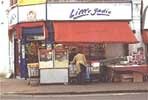|
Dormers Wells ward
Approximately that area bounded in the north and east by the Borough Boundary, west to Allenby Road and south to Uxbridge Road. It will be seen from the roads in this ward that there is a trend to acknowledge some of the greatest personalities in the fields of art and invention. However, before these names are considered I would refer to the Lane that gives the ward its name.
Dormers Wells Lane
In 1741 the lane was known as Dorman Lane after Dorman Wells. These wells were situated in the area of the allotments in the lane and a few of them are reputed to be in existence to this day. Their memory is kept alive by the designs on the badge of Dormers Wells School, which shows a spouting spring.
Farm Close
One of the latest named roads in the ward. Probably has taken its name from Ewers Farm.
Faraday Road
Michael (1791 - 1867), the eminent chemist who acquired deserved fame for his brilliant experiments in connection with electricity.
Burns Avenue
Robert (1759-1796) Scotland's greatest poet. Startled the world with a little book of poems in 1786 which proclaimed him a true son of muses. In his career he poured forth song after song of emotional tenderness, and made himself immortal.
Masefield Avenue
John Edward, appointed Poet Laureate in 1930. A prolific writer of notable poems and also of numerous plays.
Fleming Road
After Sir (John) Ambrose Fleming, inventor of the thermonic valve which revolutionised wireless telegraphy and also made wireless telephone possible.
Baird Avenue
Another inventor, John Logie Baird, who invented the Television.
Haldane Road
Professor. One of the ablest and most brilliant of present day biologists.
Darwin Drive
Charles Robert (1809-1882), this distinguished Scientist whose Origin of Species first clearly formulated and elaborated the theory of evolution.
Edison Drive
Thomas Alva, an American inventor, who, after an adventurous boyhood became a telegraph operator. Invented an improved printing telegraph (1841 -1931).
Telford Road
Thomas (1757-1834), was a Scottish working stone-mason who became a great engineer and attained special fame as a builder of bridges, the Menai Suspension Bridge being, perhaps, his greatest work.
Palgrave Avenue
After Sir Francis Palgrave (1788-1861). A much esteemed historian who wrote 'The Rise and Progress of the English Commonwealth'.
Brindley Way
After James Brindley (1716- 1772). Born near Buxton, Derbyshire, he was the engineer of the Bridgewater Canal over the Irwell. He was illiterate to his death but was a great canal maker. Nearly all the canals built in his time were connected with him in some way.
Borland Gardens
After George Morland (1761- 1804). A painter of English rural life.
Brunel Place
Isambard Kingdom (1806-1859), a prominent engineer who constructed the more difficult portions of the Great Western Railways, and many other important works and it was Brunel who designed the Wharncliffe Viaduct from which Wharncliffe Drive takes its name.
Howard Road
After Henry Howard, a portrait and historical painter who received elementary education at a school in Hounslow.
Blackwore Road
From Sir Richard, physician and voluminous writer in verse and prose.
Avenue Road
On this site there originally stood Avenue House.
Brentvale Avenue
From the River Brent nearby.
Lyndburst Avenue
Possibly ducal, in that event after Baron Lyndhurst, the Lord Chancellor of the early 19th century.
White Cole Road
'Cole' means a place for animals, here it is a link with the past, reference to the type of land.
Redcroft Road
'Croft' means a small piece of arable land especially adjoining a dwelling - a small farm. It seems certain that there must have been a farm on the site from which the road derived its name.
Stamford Close, Milford Road, Longford Road
A ford is a place where water can be crossed by wading; and it is thus possible that these names were connected with Dorman Wells.
North Road
Now purely directional, used to be called Sparrow Lane, the lane leading to Sparrow Farm.
Melrose Drive
Possibly a ducal name after the Earl, Thomas Hamilton.
Villiers Road
Named after the Earl of Jersey, - George Child.
Boyd Avenue
The last use to which the Stately Elizabethan mansion which stood in Southall Park was put, was as a private Asylum kept by Lady Ellis and later by a Doctor Boyd. The doctor and all but seven of the inmates perished in a fire that destroyed the home in 1883. The land was subsequently sold by the Earl of Jersey to the local council and the road leading to the park was named in honour of the gallant doctor.
Park Avenue
Owing to the proximity of this road to Southall Park the name is self-explanatory.
Park View Road
As has been noted elsewhere in the Society's publications Southall Park was originally the home of the Merrick Family and used as farm land. Facing the Park, on the north side of the Turnpike Road to Oxford was built a row of small cottages probably to house labourers who worked in the Park. These cottages were named 'Park View' and so when a small cul-de-sac was developed by the side of these cottages it took the same name.
Green Drive
This was once part of the golf course and presumably the name is taken from the course. Of Scottish derivation - the Avenue was originally to be named Argyll with two 'L's', but unfortunately became mis-spelt.
|

